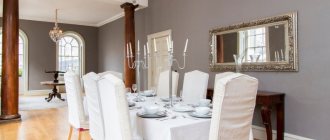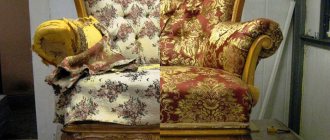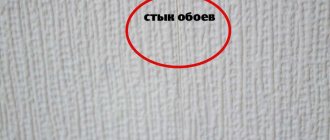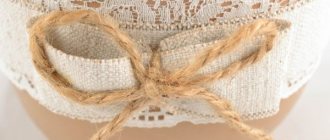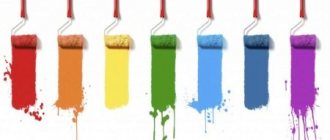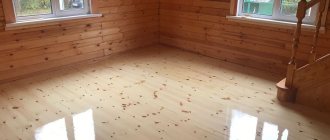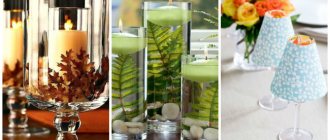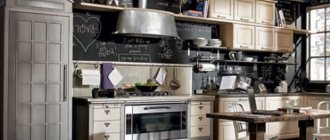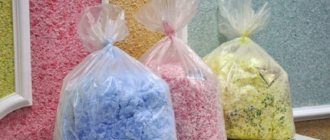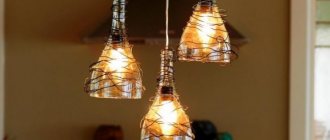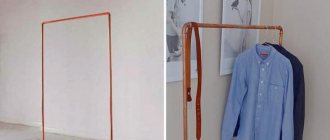Wallpaper for painting
Modern paintable wallpaper provides an excellent opportunity to change the color of the walls at any time. At the same time, the costs of this procedure will be minimal, and the effect of transforming the room will be maximum. This is very important to consider when choosing wallpaper for the kitchen. What wallpaper is suitable for the kitchen should be a deliberate decision. As for the advantages of such wallpaper for painting, this largely depends on its type.
Advantages
The general advantages are:
- Such wallpapers have a long service life; they can be repainted 8 or more times.
- You can purchase wallpaper with a white base, as well as in color; They can also be painted in any shade.
- Wallpaper for painting is presented in different types, in a large assortment, that is, the choice is quite wide.
- They are convenient and quick to glue; The width of the rolls can be up to 106 cm.
- The joints of the wallpaper edges are practically invisible.
- They are much stronger than ordinary wallpaper; they are difficult to scratch by furniture or anything else.
- It is not difficult to remove such wallpaper from the wall: just peel off one edge, pull it, and then the wallpaper can be easily removed (with the exception of glass wallpaper).
- Painted wallpaper does not fade when exposed to direct sunlight.
Types for walls and ceilings
The entire group of wallpaper intended for painting is distinguished by deep relief and the absence of a color pattern. That is why they are called textured. They differ from each other in the material on which they are made. Today there are four types of wallpaper for painting.
Paper
Usually this is a two-layer embossed paper wallpaper, the first layer of which is treated with a special moisture-resistant compound. Some manufacturers add a third layer between the base and the coating, into which sawdust and shavings are placed. In this case, a relief is created on the surface.
Paper wallpaper is impregnated with a water-repellent composition; they are quite thick and dense. They are easy to glue on a flat surface.
You can decorate both walls and ceilings with paper wallpaper. In some cases, seamless ceiling tiles are used. This creates the visual effect of a seamless surface.
Non-woven
This type is considered the most successful among all paintable wallpapers. Such wallpaper consists of a non-woven base and vinyl coating that simulates the relief. Unlike paper wallpaper, such wallpaper must be painted, since both layers are quite fragile. However, after painting they become quite strong and durable. You can change their color up to 15 times.
When gluing non-woven wallpaper, the glue is applied exclusively to the surface of the wall. This greatly simplifies the work process. In addition, they do not shrink, swell or deform.
A big advantage of non-woven wallpaper is its ability to hide wall imperfections: small unevenness, cracks, even those that formed after the sticker. In addition, they “breathe”, that is, they allow air to pass through and do not contain substances hazardous to the body. How is vinyl wallpaper on non-woven backing carried out? There are certain subtleties in gluing technology that should not be neglected.
Vinyl
The basis for vinyl covering can be not only non-woven fabric, but also paper. Vinyl wallpaper comes in white and pastel colors. The latter option is more attractive, since after applying the paint the color becomes rich and bright. The texture of the wallpaper is usually embossed (herringbone, wave, matting, pimples).
You can say exactly which wallpaper is better, vinyl or non-woven, only by carefully studying their properties and characteristics.
Glass wallpaper
They received this name due to the fiberglass threads that are connected to the paper base. As a result, the wallpaper receives a very interesting relief structure with an unusual pattern or ornament.
Decorativeness and the ability to correct small flaws in the walls are the main advantages of this type of wallpaper. In addition, glass wallpaper is wear-resistant, durable and fireproof. After painting, they can even be washed with a brush. The only negative: glass wallpaper is difficult to remove from the walls.
Linkrust
This latest trend is a material created exclusively from natural substances. The basis of this wallpaper is paper or textiles. A mixture of wood flour, wax, linseed oil, chalk and rosin is applied to them.
They must be wetted before gluing.
All types of wallpaper for painting are quite functional. They can decorate walls not only in residential premises, apartments, but also in offices, hotels and other public institutions. What paint to choose for wallpaper?
Answers to the most popular questions
Before purchasing paints, purchase wallpaper for painting. Due to the presence of a substrate and a pronounced texture, they can be used to level out the imperfections of the base, and coloring allows you to create the necessary color scheme for the interior. To avoid any questions regarding the choice and use of paint, we have collected the most frequently encountered ones and answered them.
What types of wallpaper can be painted?
Wallpaper with a relief pattern conveys the chosen shade much more effectively and allows you to disguise unevenness on the wall. Paintable wallpapers are:
- paper;
- non-woven;
- vinyl;
- liquid;
- based on fiberglass (glass wallpaper).
Structure of glass wallpaper
Can it be repainted?
The result you get at the end of painting depends on the paint you choose. The better the work is done, the more times the wall can be repainted. For example, if you want to change the shade. Paper sheets can be renewed 3-5 times, vinyl sheets no more than 10 times, non-woven fabrics up to 15 times. Glass wallpaper can withstand even more dyeing cycles.
The paint application process does not require special skills
How to get the right shade?
The paint is available in white. To obtain the required shade, color is added to it. It is important to thoroughly mix the colored component with the white base to obtain a homogeneous composition. You shouldn't add a lot of dye at once if you don't need a rich color.
When mixing manually, even if the proportions of dyes are observed, it can be difficult to obtain the same shade. Therefore, it is recommended to use a mechanized mixing method. The task becomes more complicated if it is necessary to obtain a complex shade consisting of a white base and several colors. First, it is recommended to mix the colors in the required proportion until smooth, and then gradually introduce them into the white paint.
Obtaining the required shade experimentally takes a lot of time. There is another way. Computer tinting service, which is provided in large construction and specialty stores. In accordance with the shade selected in the catalog, the computer program provides information about the quantity and proportion of dye for a certain volume of paint that will need to be used. This allows you not to buy or dilute paint with a reserve, but to “act according to circumstances.”
Fan of tinting shades
How to choose the right shade?
When choosing a wall shade, it is recommended to take into account not only your own preferences, but also other criteria:
- purpose of the premises;
- design style;
- room area;
- planning features;
- color scheme of adjacent rooms;
- orientation of the room to the cardinal points;
- amount of natural light.
So, for small rooms choosing light shades. Beige color is universal - it is an excellent background for furniture and other decoration. Bright colors are chosen for the living room, and calm, pastel ones for the bedroom. For “southern” rooms, a cool color scheme is better, and for “northern” rooms, on the contrary, a warm color scheme. The glossy effect makes the room more spacious and solemn, and the matte texture makes it more comfortable.
Coloring textured wallpaper
How much paint will be needed?
Calculating the amount of paint for an ordinary rectangular room is not difficult. It is necessary to calculate the area of each wall. If there is a window or doorway on the wall, then calculate its area and subtract it from the area of the wall.
For example, for a room 2.3 m high and walls 3 x 4 m long, with a doorway 2.1 x 8 m and a window 1 x 1.2 m, you will need to make the following calculations:
- (3 x 4) x 2 x 2.3 = 55.2 m2 – wall area;
- (2.1 x
 + (1 x 1.2) = 18 m2 – area of the door and window opening;
+ (1 x 1.2) = 18 m2 – area of the door and window opening; - 55.2 – 18 = 37.2 m2 – wall area that will be painted.
It happens that the calculations were made correctly, but there was still not enough paint. The reason may be the absorbency of the material that is being painted. But this applies to porous surfaces, which should be coated with a primer a couple of times before painting.
As a guide, you should follow the information on the paint packaging. Here the manufacturer indicates the consumption.
Paintable wallpaper is increasingly being used to decorate a modern home.
How long does it take for paint to dry?
Painting is done in several layers. The time interval specified by the manufacturer on the packaging must be maintained between applications. Sometimes it is 1 hour, sometimes from 2 to 4 hours.
If we compare how the surface dries faster - a wall without wallpaper or covered with wallpaper for painting, then in the second case it will take more time due to the porosity of the material. In order for the paint to dry within the time interval specified by the manufacturer, it is necessary to maintain the recommended humidity level and temperature in the room.
It is necessary to ensure a flow of fresh air into the room, but avoid drafts. It is also not recommended to speed up the drying process by exposing the painted surface to hot air.
Video - How to paint wallpaper for painting?
Types of wallpaper paints
The type of wallpaper paint is selected according to the type of wallpaper. The appearance of the walls and the wear resistance of the paint largely depend on this. Today there are three types of water-soluble paints intended for painting wallpaper:
- Acrylic:
- Latex;
- Polyvinyl acetate (PVA);
Acrylic
Acrylic paint is in greatest demand. It is durable, quite moisture resistant; The range of colors on the market is huge. In addition, acrylic paint dries almost instantly.
Water-soluble and water-emulsion
Water-soluble or water-based PVA-based paint is the cheapest of all types. But its characteristics are inferior to other types of paints. It is afraid of moisture, so it is suitable for painting ceilings exclusively in dry rooms.
Latex
Latex paint adheres perfectly to wallpaper, creating a silky matte surface. High moisture resistance is the main advantage of latex paint.
When purchasing latex paint, pay attention to the gloss level indicated on the label. The higher it is, the more moisture-resistant the paint is.
Paper wallpaper can be painted with any colorful material presented above. However, latex paint works best on paper.
Non-woven and vinyl wallpapers are more prone to acrylic, but latex paint is also quite suitable for them. But if we are talking about painting the inside of the wallpaper (this is possible for some types of non-woven wallpaper), then only acrylic paint is used.
To paint fiberglass wallpaper, use any of the above water-based paints.
What kind of wallpaper paint is there for painting?
You need to choose the right wallpaper paint for painting so that it is pleasant to look at the walls and comfortable to be in the room. Painting wallpaper won't take a lot of energy or material resources; it's an easy way to “refresh” a room.
Wallpaper paint for painting should be chosen depending on the type of wallpaper that will need to be first pasted and then painted.
Types of wallpaper for painting
- Paper (quite thick, suitable for any surface);
- Fiberglass (able to correct flaws on walls, strong, durable);
- Non-woven (smooth out unevenness, hide cracks on walls, very dense).
What they all have in common is that they can be painted many times. Typically, such wallpaper is initially unpainted. But you can also find colored wallpapers, in which case they can be gray, beige, cream, blue or pink.
The catch here is that wallpaper paint for painting should be perfectly absorbed and not spread (textures that are too liquid will not work).
Non-woven wallpaper remains one of the most popular. They can be repainted several times. Read more about this in our article:
What does the modern market offer?
The modern market is replete with a wide range of textures and colors that are used in wallpaper for painting. Everyone will be able to choose exactly the option that ideally matches the style and design of the room being decorated and paint them in the desired color. In addition, various wax pastes can be used to decorate individual parts and relief elements. Can be coated with glaze, varnish or shaded. All this will help make your living space unique. To make changes, you can use decorative plaster with your own hands from ordinary putty.
The choice of manufacturers of wallpaper, paints, and adhesives is also very wide. Foreign wallpaper manufacturers:
- "ERFURT", "MOHR", "MARBURG", "ERISMANN", "AS CREATION", "ERISMANN", (Germany).
- "MITEX", "TASSO GLASS" (Sweden).
- "FINTEX", "ASSATEX" (Finland).
- "MERMET" (France).
- "ARTE" (Belgium).
Among the paints, the most popular brands are: Dufa, Tikkurilla, Garmonia, Beckers-3, EURO12.
The sizes of rolls of textured wallpaper for painting sometimes differ from the standard ones (10.05 x 0.53 m) in the direction of increase. You can find wallpaper with dimensions 17 x 0.53; 25 x 1.06; 33.5 x 0.53 and even 125 x 0.75 m. The maximum length allows you to use material more efficiently and almost get rid of scraps. Double width helps reduce the number of joints.
Latex wallpaper paint for painting: its effect
Latex paint is also quite popular. Latex wallpaper paints for painting are elastic, they perfectly resist moisture and are not susceptible to mechanical damage. The only downside is that latex paints are not very cheap. But this is the case when the price matches the quality. Latex wallpaper paint for painting is characterized by the fact that it can withstand water (if it accidentally gets on the wallpaper and paint) and the rays of the sun - it does not fade under their influence.
Paintable wallpaper made from paper will become glossy after applying latex paint.
How glossy it is depends on the paint and should be indicated on the packaging. Therefore, you need to study the packaging before purchasing so that there are no disappointments in the future. In addition, the higher the gloss level, the better the water resistance.
If you use latex wallpaper paint for painting in the kitchen, you may be pleasantly surprised. Everyone is used to the fact that wallpaper in the kitchen quickly gets dirty. The advantage of latex paint is that if you paint wallpaper with it, it will wash well.
Latex paint is one of the most expensive paints, but it is needed for long-term use. This is the paint that experts recommend painting wallpaper with.
How to glue it yourself
There is nothing complicated about painting and gluing yourself. In order to glue and paint, you will need the following tools and materials:
- paint and coloring element;
- fur roller and brushes;
- plastic bath;
- gloves;
- container for diluting paint;
- masking tape;
- acrylic varnish (if necessary).
How to paint:
- Preparing the walls. The wallpaper on the walls should dry well. There is no need to rush into painting; it is better to wait for the time specified in the instructions. Usually this is 2-4 days after wallpapering. If bubbles have formed in certain areas, they must be cut and re-sealed with PVA glue. Painting should begin after the areas have completely dried.
- Dilution of paint. Here it is important to follow the proportions indicated in the instructions. Important! The diluted composition should not be too liquid.
- Applying paint. To do this, use a roller made of porous material, for example, foam rubber. During operation, smudges may form. They need to be carefully collected with the end of the roller, then paint over the area again. The same goes for the bubbles that sometimes form when painting.
Work should not be carried out with open windows. This promotes the formation of air bubbles.
Things to consider
- The paint dries from 2 to 14 hours. After this, you can apply a second layer of paint: the color shade will be more beautiful and rich.
- Use a paint brush where it touches the floor. Pre-cover the baseboard with masking tape.
- If desired, the painted surface can be coated with acrylic varnish. This coating will provide protection from dirt, so this is an ideal solution for the kitchen, hallway and children's room.
- If you can’t find the right shade of paint, tint the white base with any of the tint dyes.
Types of paint
Choosing paint for wallpaper is not difficult, but it is a crucial moment. Manufacturers offer a fairly wide range of products that can satisfy the needs of any customer. They have a rich range of colors, are glossy and matte, and have different compositions and areas of application. As a rule, paint should be selected not only according to the type of wallpaper for which it is suitable, but also according to other important characteristics. This:
- environmental friendliness;
- resistance to mechanical damage;
- resistance to sunlight;
- moisture resistance;
- shine;
- complete drying time.
For interior work, interior paints are usually used. They can be divided into two main types: alkyd and water-dispersion.
Alkyd paints
They are used mainly for painting glass wallpaper. Alkyd paint is capable of creating a durable protective film on the surface, thanks to which the wallpaper can be washed with various detergents without fear of damaging the top layer.
Alkyd paints for painting wallpaper
The same property also applies to its disadvantages, since the walls under such a film stop “breathing”. In addition, the use of alkyd paint composition is prohibited in the children's room, bedroom and kitchen due to the content of some toxic substances. It is also not recommended to use alkyd paint for embossed wallpaper; it can smooth out its pattern, so in this case it is better to choose smooth wallpaper.
Water-dispersion paints
This includes water-based coloring compositions using various binding emulsions and latexes. They are very popular because of their qualities, first of all.
Water-dispersion paints are odorless, dry quickly and are environmentally friendly. The film formed on the painted surface protects the wallpaper from minor damage, but at the same time allows air to pass through. This property helps prevent the formation of fungi and mold. Moreover, water-dispersion compositions have high moisture resistance, which allows them to paint surfaces in rooms with high humidity.
Mixing water-dispersed paints
They are:
- latex;
- latex-based acrylic;
- acrylic;
- water-based.
For all types of wallpaper, latex paint is best. When stained, they will not get wet or peel off. Due to its properties, the latex composition is able to strengthen the surface structure of the finishing material, which increases the durability of the coating and allows it to be washed.
Latex-based acrylic paints make up the majority of all water-based paints. To obtain a high-quality and elastic coating, they are applied in several layers.
For non-woven wallpaper, water-based acrylic paint is better suited.
One of the important criteria when choosing a material for painting a surface is shine or gloss. Special attention should be paid to this fact.
Acrylic interior paint
Interior paint can be:
- Glossy . It is used extremely rarely for residential premises; it tends to highlight the shortcomings of the walls. Well suited for dark rooms, but in bright and sunny rooms it can cause some discomfort;
- Semi-gloss . Has good reflective ability, recommended for covering wall surfaces in the kitchen and children's rooms;
- Matte . Paint that lacks shine can mask some defects in the surface being painted. Most often, it is used in large rooms;
- Semi-matte . It has a slight gloss and smoothes out minor irregularities well. Great for bedroom walls.
- Satin . Has a smooth structure. Intended for premises of any type. Has increased wear resistance and durability.
Conclusion
Paintable wallpaper is an excellent solution for frequently changing the decor of a room. Their use will significantly save time and physical effort during subsequent repairs. It will be enough just to repaint the walls or ceiling if there is wallpaper that can be painted. And it’s not at all difficult to do this; you can do it on your own without involving professionals. And the wide selection of materials offered on today’s market will allow you to create a unique interior in any room.
We also recommend that you familiarize yourself with the types of granite.
Acrylic paint for wallpaper for painting
Acrylic paint is the most popular type of wallpaper paint for painting. It is quite wear-resistant and moisture-resistant. In addition, there are a huge number of colors and shades of acrylic paint. It can also be safely used in rooms where humidity is high. Acrylic wallpaper paint for painting costs less than latex paint. It is a fairly high quality paint. After painting with this product, the surface becomes of high quality. In addition, you don’t have to spend a lot of money to get a good result - this is one of the advantages of acrylic paint.
Acrylic paint is characterized by high resistance to moisture, it practically does not wear off, so it can be used in any room, even in the kitchen. The top can be covered with glitter.
